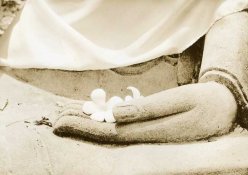mooseontheloose
Moderator
This may seem like a weird question. I've been dabbling in lith for the past year and a half (is that all?!) and I'm pretty good at spotting a lith print when I see one. However, the other night I was experimenting with a 'new' paper (some Fuji Fujibro RC paper I got while in Japan) to see if it would lith. I already did the drop of solution B test to make sure there was no accelerator present (there wasn't).
Anyway, I was doing this in conjunction with some Foma MG 132 (my favorite) in Moersch SE5 1+20 dilution (plus D additive). The Foma came up in 4-5 minutes, but the Fujibro took much longer -- 17 minutes. It did appear to me that some infectious development occurred -- the blacks definitely came up first, it's more 'gritty' and has a very weak colour response. Which prompted the question -- is this what non-lithable papers look like in lith? Or does something different happen? The only other paper I've tried is Ilford Multigrade Warmtone and it's response is much different than what happened with the Fujibro. Unfortunately, all the papers I have in my freezer are lith papers, other than Ilford RC postcard paper, so I can't really experiment with other papers to see if the response is similar.
I've re-looked at Tim Rudman's books but they are mostly about what papers are suitable for lith and how they look, not how unsuitable papers look in lith. This may seem like an obvious question, but it's one I'm not quite sure what the answer is.
FWIW, I know there's a lot more experimenting I could do with the Fujibro to see if it would have a different response to different lith processes.
I'm attaching three examples here. Unfortunately my scanner could not capture the subtle colours in the 'lith' prints so I've had to adjust them the best I can -- not sure how successful I was. They definitely have a warmtone or very light sepia colour to them. (Looking at them again I could not get the colour right for the third print. It should be slightly warmer looking).
The first picture is of the normal B&W print. The second was exposed for 1 minute (about 2 stops overexposed) and developed for 17 minutes. The third was a test strip exposed at 2/2.5/3 minutes and developed for 17.5 minutes.
Anyway, I was doing this in conjunction with some Foma MG 132 (my favorite) in Moersch SE5 1+20 dilution (plus D additive). The Foma came up in 4-5 minutes, but the Fujibro took much longer -- 17 minutes. It did appear to me that some infectious development occurred -- the blacks definitely came up first, it's more 'gritty' and has a very weak colour response. Which prompted the question -- is this what non-lithable papers look like in lith? Or does something different happen? The only other paper I've tried is Ilford Multigrade Warmtone and it's response is much different than what happened with the Fujibro. Unfortunately, all the papers I have in my freezer are lith papers, other than Ilford RC postcard paper, so I can't really experiment with other papers to see if the response is similar.
I've re-looked at Tim Rudman's books but they are mostly about what papers are suitable for lith and how they look, not how unsuitable papers look in lith. This may seem like an obvious question, but it's one I'm not quite sure what the answer is.
FWIW, I know there's a lot more experimenting I could do with the Fujibro to see if it would have a different response to different lith processes.
I'm attaching three examples here. Unfortunately my scanner could not capture the subtle colours in the 'lith' prints so I've had to adjust them the best I can -- not sure how successful I was. They definitely have a warmtone or very light sepia colour to them. (Looking at them again I could not get the colour right for the third print. It should be slightly warmer looking).
The first picture is of the normal B&W print. The second was exposed for 1 minute (about 2 stops overexposed) and developed for 17 minutes. The third was a test strip exposed at 2/2.5/3 minutes and developed for 17.5 minutes.
Attachments
Last edited by a moderator:














